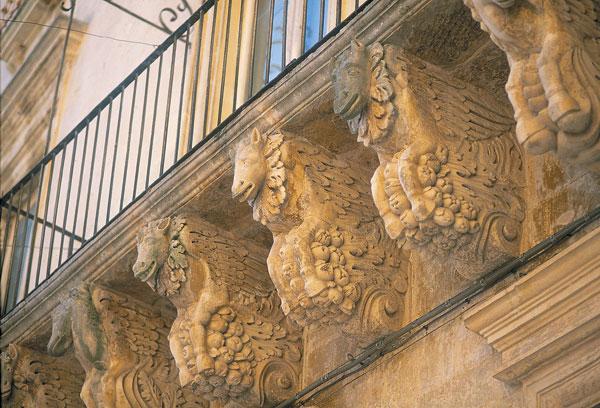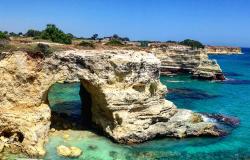If you travel as far south-east as you can in Italy to the Salentine peninsula - deep into the heel of the Italian boot - you come to the wonderful Puglian gem of Lecce, one of the most important Baroque cities in Italy. Dubbed the ‘Florence of the South’, it is a sophisticated university town, and a centre of religious study, the arts and early music.
While still functioning as a workaday commercial centre for the surrounding Province, it blends this agreeable mix against a backdrop of dignified, though sometimes crumbling, baroque extravagance. Since it is situated almost as far south you can go, it is some way off the tourist coaches’ regular path, and this is where any similarity to Florence ends. Therein lies part of its appeal. It has that very distinctive southern feel: the intense heat of long summers, the warm-toned stone that responds gloriously to strong, raking light, the unhurried pace of life, and the friendliness of the local people. Like everywhere in Puglia, you are never far from the sea. Lecce’s 10 kilometres to the Adriatic meant that the duomo’s tower once even doubled up as a lighthouse!
The city is surrounded by large expanses of fairly flat countryside covered with olive trees and vines and curious beehive-shaped stone shelters. The very fabric of this landscape provided the famous stone, or pietra leccese, that was used to cram the sophisticated main centre of the city with distinctive fine architecture, or ‘Baroque Leccese’. Once a Greek settlement, it flourished in Roman times and, during the 16th and 17th centuries, Lecce gradually evolved from a towered Renaissance city into the Baroque splendour that was commissioned by wealthy aristocrats, bourgeoisie, clergy and religious orders.
First Port of Call
Late spring or early summer is a perfect time to travel to Lecce, especially if you are touring by car. At this time, you avoid the intense heat of July and August but still enjoy all the warm sunshine and blue sky you could want. There are other advantages, too: poppies and wild flowers abound in the countryside, and the roads are clear of the flocks of recreational vehicles that seem to migrate across the whole of Europe in the summer months. From April onwards it is usually warm enough to swim in the nearby Adriatic, and to eat outside in the evenings.
The Museo Provinciale is often the first port of call for visitors to Lecce. It is probably best to park nearby and leave the car while you explore the town as well. Also known as the Museo Castromediano, or the Museo Archeologico, it is housed in a modern building just on the southern edge of the centro storico. Here, there are early examples of local ceramics, including some fine Attic vases, together with statues from the Roman theatre, and articles from early Lecce churches, including a Polyptych by Veneziano.
Apart from the first half of the afternoon, when all the locals disappear home in classic southern style, Lecce is a busy place, and the best way to explore the compact old centre is on foot. As you leave the museum, follow the Viale Francesco Lo Re up to the Porta Biagio, set into the ancient city walls rebuilt by Charles V, testament to Lecce’s role as a seat of royal power in the 17th and 18th centuries. Here you have your first encounter with Lecce Baroque - on the right is Chiese di S Matteo with its unusual bowed façade with rich decoration. Look inside at the elliptical interior with its elaborate altars. Continuing in the same direction, you soon reach Santa Chiara on the left. This church has a papier mâché ceiling and some fine statues in its octagonal interior. However, if you take the left turn just before the church you can make a brief detour to see the Teatro Romano. If you are short of time, carry on past Santa Chiara until you reach Piazza Sant‘Oronzo, the hub of the old city.
This expansive piazza is dominated by Brindisi’s Via Appia column. This column was once one of pair that marked the end of the Appian way at the waterside of Brindisi, and was presented to the city of Lecce. Now it is surmounted by the carved figure of Sant‘Oronzo, the Bishop of Lecce who was martyred by Nero in the first century AD. A feast in August celebrates this Patron Saint‘s day with a Palio. Below the column lies the Roman amphitheatre dating from the first century BC, and originally accommodating 20,000 spectators. It is still used for dramatic performances and musical concerts in the summer season. The façade of the fine Baroque church, Santa Maria delle Grazie, faces the column, as well as the 16th- century Sedile, once the town hall, and the chapel of San Marco. There is no shortage of good places to pause for a coffee or cold drink while you contemplate the fate of poor Oronzo, or engage in the fascinating pastime of people-watching.
Riot of Detail
Moving north from this piazza, resume your tour of the city, walking up Via Rubichi. Around nearly every corner of Lecce there is a beautiful doorway or balcony, but this still does not prepare you for the riot of incredible detail carved into the soft stone of Santa Croce, Lecce‘s most cele-brated church. The soft, easily worked local sandstone that was used to carve these sharply detailed exuberances has hardened over the years so that this building is still in incredibly good condition. It took 150 years to complete the church for the Celestine order, and its Baroque façade rejoices in intricately-designed balconies, arches, columns and friezes which are alive with carved figures, flowers and animals. The upper section of the façade houses a wonderful rose window by Giuseppe Zimbalo who was also responsible for the façade of the seminary next door, as well as several other buildings in Lecce. Inside, there is a fine timber ceiling, reconstructed in the 19th century, with a 16th-century cupola suspended above the transept.
To the left is the chapel of S Francesco da Paola by Francesco Zimbalo, Giuseppe’s brother. Next door to Santa Croce stands the imposing 17th-century Palazzo Governo, originally built as a convent for the Celestine Order, and containing a wonderful cloister. Keen church visitors might continue further north to a group close together on the northern edge of the old town. There, you will find Santa Giovanni Evangelista, Santa Angelo and Chiesa della Provvidenza and, just outside the city walls, SS Niccolo e Cataldo, Baroque again, but with 12th-century origins and fine cloisters adjacent to the main church.
Back at Piazza Sant‘Oronzo, and after another cold drink, venture westwards a little way down Via Vittorio Emanuele stopping at Sant‘Irene with its finely detailed Baroque interior. You may also find yourself pausing at the smart shops that line this elegant street. Soon, you will reach the beautiful Piazza del Duomo on the left, its entrance framed on either side by the stone figures standing on balconies. The duomo was originally built in the 12th century but was restored in its present form in 1570 by - you guessed it - Giuseppe Zimbalo. Inside, there are unusual wooden and papier mâché statues, as well as several noteworthy paintings and an excellent coffered ceiling.
Architectural array
Standing to the left of the cathedral is the graceful Palazzo Vescovile, or bishop‘s palace, while to the right of the duomo stands the seminary, which completes the Piazza‘s beautiful architectural array. This seminary was known for its training of high voices, and supplied castrati singers to the Vatican. If you continue along Via Vittorio Emanuele, it turns into Via Giuseppe Libertini and leads to the Chiesa del Rosario on the left, yet another church by Giuseppe Zimbalo and thought by many to be his finest. Beyond the church you reach the Porta Rudiae, a fine 18th-century gate set into the western edge of the city walls.
Although it is not in the guidebooks, a few visitors make the short way down Via Guiseppe Palmieri, which begins opposite the entrance to the Piazza del Duomo. This leads to the tiny Piazza Salconieri where you find the 16th-century Palazzo Balsamo with a wonderful balcony supported by four figures on either side - restored but still betraying the ravages of the years. A little further on, a right turn down Via Leonardo Prato brings you to still another of Lecce‘s celebrated churches, the stern Gesu with its lavish baroque interior. Head right as you leave this church to return to Piazza Sant’Onofrio. Many more lesser buildings and details are there to delight the visitor, and part of the pleasure of Lecce is in walking the side streets finding your own personal favourites.
If you tire of excessive exposure to Baroque, you might find a tour of the surrounding area a welcome contrast. Outside Lecce, and on a much smaller scale, Acaia has a very fine Renaissance gateway into the quiet and attractive fortified town. From here, the pleasant drive to the coast takes you to San Cataldo, a small seaside resort with a good sandy beach. Further along the coastal route is Roca Vecchia, a popular fishing spot with beautiful sea and the crumbled remains of its ancient Messapian site, as well as several dolmen scattered around this area.



